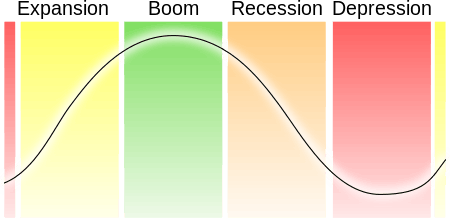Kitchin cycle
 | |
|---|---|
| Cycle/Wave Name | Period (years) |
| Kitchin cycle (inventory, e.g. pork cycle) | 3–5 |
| Juglar cycle (fixed investment) | 7–11 |
| Kuznets swing (infrastructural investment) | 15–25 |
| Kondratiev wave (technological basis) | 45–60 |
Kitchin cycle is a short business cycle of about 40 months discovered in the 1920s by Joseph Kitchin.[1]
This cycle is believed to be accounted for by time lags in information movements affecting the decision making of commercial firms. Firms react to the improvement of commercial situation through the increase in output through the full employment of the extent fixed capital assets. As a result, within a certain period of time (ranging between a few months and two years) the market gets ‘flooded’ with commodities whose quantity becomes gradually excessive. The demand declines, prices drop, the produced commodities get accumulated in inventories, which informs entrepreneurs of the necessity to reduce output. However, this process takes some time. It takes some time for the information that supply significantly exceeds demand to get to the businesspeople. As it takes entrepreneurs time to check this information and to make the decision to reduce production, time is also necessary to materialize this decision (these are the time lags that generate the Kitchin cycles). Another relevant time lag is the lag between the materialization of the afore mentioned decision (causing the capital assets to work well below the level of their full employment) and the decrease of the excessive amounts of commodities accumulated in inventories. Yet, after this decrease takes place one can observe the conditions for a new phase of growth of demand, prices, output, etc.[2]
See also
References
- ↑ Kitchin, Joseph (1923). "Cycles and Trends in Economic Factors". Review of Economics and Statistics. 5 (1): 10–16. JSTOR 1927031. doi:10.2307/1927031.
- ↑ Korotayev, Andrey V.; Tsirel, Sergey V. (2010). "A Spectral Analysis of World GDP Dynamics: Kondratieff Waves, Kuznets Swings, Juglar and Kitchin Cycles in Global Economic Development, and the 2008–2009 Economic Crisis". eScholarship. Structure and Dynamics. UC. 4 (1): 3–57.